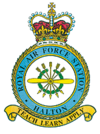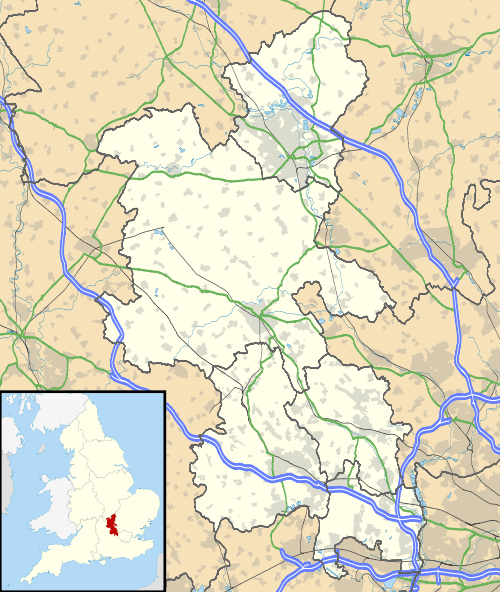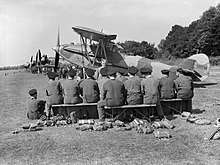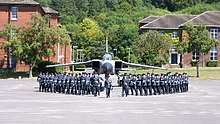RAF Halton
Royal Air Force Halton, or more simply RAF Halton, is one of the largest Royal Air Force stations in the United Kingdom. It is located near the village of Halton near Wendover, Buckinghamshire. The site has been in use since the First World War but is due to close by 2025.
| RAF Halton | |||||||||
|---|---|---|---|---|---|---|---|---|---|
| Near Aylesbury, Buckinghamshire in England | |||||||||
 Entrance to RAF Halton | |||||||||
 Teach Learn Apply | |||||||||
 RAF Halton Shown within Buckinghamshire | |||||||||
| Coordinates | 51°47′30″N 000°44′10″W | ||||||||
| Type | Royal Air Force training station | ||||||||
| Area | 297 hectares (730 acres)[1] | ||||||||
| Site information | |||||||||
| Owner | Ministry of Defence | ||||||||
| Operator | Royal Air Force | ||||||||
| Controlled by | No. 22 Group (Training) | ||||||||
| Condition | Operational | ||||||||
| Website | www | ||||||||
| Site history | |||||||||
| Built | 1913 | ||||||||
| In use | 1913–present | ||||||||
| Garrison information | |||||||||
| Current commander | Group Captain Katherine Wilson | ||||||||
| Occupants |
| ||||||||
| Airfield information | |||||||||
| Identifiers | ICAO: EGWN | ||||||||
| Elevation | 113.38 metres (372 ft) AMSL | ||||||||
| |||||||||
| Source: RAF Halton Defence Aerodrome Manual[2] | |||||||||
The Duchess of Cornwall is the Honorary Air Commodore of RAF Halton.
History
The first recorded military aviation at Halton took place in 1913 when the then owner of the Halton estate, Alfred de Rothschild, invited No 3 Squadron of the Royal Flying Corps to conduct manoeuvres on his land. Following a gentlemen's agreement between Rothschild and Lord Kitchener, the estate was used by the British Army throughout the First World War. In 1916 the Royal Flying Corps moved its air mechanics school from Farnborough, Hampshire to Halton, and in 1917, the school was permanently accommodated in workshops built by German PoWs.[3][4]
The estate was purchased by the British Government for the nascent Royal Air Force at the end of the First World War for £112,000.
In 1919 Lord Trenchard established the No. 1 School of Technical Training at RAF Halton for RAF aircraft apprentices,[5] which remained at the station until it moved to RAF Cosford in the early 1990s.[6] Also in 1919, Halton House – a French-style mansion built for Lionel de Rothschild – was re-opened as the station's Officers' Mess, a role which the grade II listed building continues as today.[7]

During the Second World War, RAF Halton continued its training role. Additionally No 112 Squadron and No 402 Squadron of the Royal Canadian Air Force were based at Halton for part of the war. No. 1448 (Radar Calibration) Flight was converted into No. 529 Squadron at Halton in June 1943. Initially, the squadron flew the Cierva C.30 and the de Havilland Hornet Moth and by the end of the war, the squadron was competent with autogyro aircraft.[8][9]
In July 1952 the uncrowned Queen Elizabeth II performed one of her first duties as Sovereign by presenting a colour to Number 1 School of Technical Training; the first to be awarded to an apprentice school, and the first to be presented to an 'other rank' when Sergeant Apprentice Hines, of the 63rd Entry, received the colour from Her Majesty.[10]
When No. 1 School of Technical Training moved to RAF Cosford in 1993, they took over guardianship of the Queen's Colour and on 31 October 1997, Her Majesty presented RAF Halton with its second colour. RAF Halton was the only station to be granted the dignity of two Queen's colours.[11] The move of No. 1 School of Technical Training to RAF Cosford afforded space for the RAF School of Recruit Training to be moved from RAF Swinderby to RAF Halton in July 1993, where it has been ever since.[12] In the year 2004-2005, RAF Halton trained 24,000 personnel, though not all were Phase 1 recruits; some were attending the Airman's Command School which trains Non-Commissioned Officers (NCO) in Phase 2 and 3 disciplines.[13][14]
From 1917–1963, a spur railway line ran from Wendover to Halton to supply coal and goods to the station.
The history of the RAF station and specifically apprenticeship training over the years is preserved by the Trenchard Museum located at RAF Halton, and managed by the RAF Halton Apprentices Association.[15] In 2010 a major project by members of the station re-excavated the training trenches used during the First World War and made them available as an educational exhibit.[16]
No. 613 Volunteer Gliding Squadron, which operated the Grob Vigilant T1, was disbanded in November 2016 by the MoD as part of its Better Defence Estate strategy.[17]
In July 2018, the headquarters of the Logistics Specialist Training Wing (LSTW) relocated to the new Defence College of Logistics, Policing and Administration at Worthy Down in Hampshire. It is expected that the remaining element of the LSTW, the Logistics Supply Training Squadron, will move to Worthy Down during 2019 or 2020.[18]
The following units were here at some point:[19]
- No. 1 Air Stores Park
- No. 2 Air Stores Park
- No. 3 Air Stores Park
- No. 4 Air Stores Park
- No. 5 Air Stores Park
- No. 5 (Signals) Wing RAF
- No. 6 Air Stores Park
- No. 7 Air Stores Park
- No. 9 Personnel Holding Unit (WAAF)
- No. 23 Group Communication Flight RAF
- No. 24 Elementary Flying Training School RAF
- No. 24 Group Communication Flight RAF
- No. 24 (Technical Training) Group RAF
- No. 24 (Training) Group RAF
- No. 60 Group Communication Flight RAF
- No. 121 Gliding School RAF
- No. 122 Gliding School RAF
- No. 612 Volunteer Gliding School RAF
- No. 613 Gliding School RAF
- No. 1448 (Radar Calibration) Flight RAF
- No. 2759 Squadron RAF Regiment
- Bomber Command Communication Flight RAF
- Polish Technical Training School
- RAF Depot
- School of Parachute Training
- School of Technical Training (Boys)
- School of Technical Training (Men)
RAF Hospital Halton
Princess Mary's RAF Hospital Halton was opened in 1927 as a large purpose-built military hospital, replacing an earlier makeshift medical facility housed in wooden huts that had been opened in 1919. The hospital was the second unit in the United Kingdom to have a renal facility, and besides developing a cure for Sandfly fever, the hospital was the first in the world to use penicillin on a large scale in 1940, just after its discovery.[20]
The hospital was closed in 1995 due to Government defence cuts. The buildings remained derelict until 2007–08 when they were demolished for new housing in a development called Princess Mary Gate.[21]
Role and operations

Halton is the RAF's centre for recruit training and airmen's development training, and also hosts other independent units. Units based at Halton include:
- Recruit Training Squadron – initial training for all non-commissioned entrants to the RAF (including the integration of the RAF Regiment entrants from April 2016 as part of a new mission statement).
- Airmen's Command Squadron – leadership and management training for non-commissioned officers.[14]
- Specialist Training School – Health and Safety, Environmental Protection, Quality Management and Management and Procedural Skills Training.
- Joint Information Activities Group (JIAG) – a merger of Defence Media Operations Centre (DMOC) and the Joint Information Operations Training and Advisory Team (JIOTAT).[22]
- Joint Media Operations Centre – media and communications training and a deployable joint media operations team; part of the JIAG.
- Supply & Movements Training Wing, part of the Defence College of Logistics, Police and Administration (DCLPA) – trains RAF personnel in supply, movements and logistic management. It also trains Royal Navy and British Army personnel in movements disciplines.
- Training Analysis Centre (part of No 22 (Training) Group) – carries out training needs analysis, and proposes training strategies for RAF ground trades and branches (with the exception of medical, musician and fire-fighter).
- Defence Centre of Training Support[23] – training military instructors and training managers, e-learning support services to the MoD, computer-based training production.
- No 7644 (VR) Squadron, RAuxAF[24] – a specialist media operations squadron.
- Joint Service Gliding Centre – training[25] in the form of gliding for members of the Armed Forces.
- Headquarters Hertfordshire & Buckinghamshire Wing Air Training Corps.[26]
- No 6 RAF Police Sqn. – providing Law Enfocement, Protective Security and 24/7 security to RAF Halton and its lodger units.
_of_the_RAF_Halton_Microlight_Flying_Club_arrives_RIAT_Fairford_17July2017_arp.jpg)
As of 2017, logistics services to RAF Halton are provided by a multi-activity contract awarded to Serco.
Airfield
The site has a grass airfield, used mainly by gliders, light aircraft, microlights and the RAF hot air balloon.[27] The airfield is the home of the Royal Air Force Gliding & Soaring Association,[28] Chilterns Gliding Centre, The Halton Aero Club[29] and the RAF Halton Microlight Club.[30]
Based units
Flying and notable non-flying units based at RAF Halton.[31][32][33]
Royal Air Force
No. 38 Group (Air Combat Service Support) RAF RAF Voluntary Bands Association
|
British ArmyArmy Recruiting and Training Division
Joint Forces CommandDefence Academy Directorate of Joint Warfare
Civilian
|
Future

On 7 November 2016, in a speech to the House of Commons by the Defence Secretary, it was announced that the RAF Halton airfield would cease to be part of the Ministry of Defence (MoD) estate and was scheduled to be disposed of by 2022.[34] The following month, a letter from the Defence Secretary to MP David Lidington confirmed the planned phases prior to disposal of the site:
- Phase 1 – Airfield disposal.
- Phase 2 – Relocation of School of Recruit Training and Airmen's Command School to RAF College Cranwell.
- Phase 3 – Relocation / rationalisation of lodger units.
On 28 February 2019, after a revision of the Defence Estates Optimisation Plan, MoD minister Tobias Ellwood MP announced that RAF Halton would not close until at least 2025.[35] This was confirmed in letters sent from the Defence Infrastructure Organisation in May 2019 to local residents, stating that phased withdrawal would commence in 2022 with full disposal achieved in 2025.
References
- "Defence Estates Development Plan 2009 – Annex A". GOV.UK. Ministry of Defence. 3 July 2009. p. A3. Retrieved 12 July 2020.
- "RAF Henlow Defence Aerodrome Manual (DAM)" (PDF). RAF Halton. Military Aviation Authority. 27 January 2017. Archived from the original (PDF) on 24 August 2017. Retrieved 23 August 2017.
- Bowyer 1983, p. 148.
- "Plane sailing at airshow". Buckinghmshire Herald. 18 June 2008. Retrieved 31 July 2017.
- Bowyer 1983, p. 149.
- "RAF - RAF Cosford History". Raf.mod.uk. Retrieved 31 July 2017.
- Historic England. "Halton House (Grade II) (1000601)". National Heritage List for England. Retrieved 31 July 2017.
- Lake, Alan (1999). Flying units of the RAF : the ancestry, formation and disbandment of all flying units from 1912 (1 ed.). Shrewsbury: Airlife. p. 266. ISBN 978-1-84037-086-7.
- Halley, James J. (1988). The squadrons of the Royal Air Force & Commonwealth 1918-1988. Tonbridge: Air-Britain. p. 402. ISBN 978-0-85130-164-8.
- Pitchfork, Graham (2008). The Royal Air Force day by day (1 ed.). Stroud: Sutton. p. 240. ISBN 978-0-7509-4309-3.
- "RAF - News". Raf.mod.uk. 24 May 2017. Retrieved 31 July 2017.
- "Swinderby". Forgottenairfields.com. Retrieved 31 July 2017.
- "Safer Training; Managing risks to the welfare of recruits in the British armed services" (PDF). Bbc.co.uk. Adult Learning Inspectorate. 2005. p. 67. Retrieved 31 July 2017.
- "RAF - Airmens Command Squadron". Raf.mod.uk. Retrieved 31 July 2017.
- Brooks, Clive. "RAFHAAA Page". Oldhaltonians.co.uk. Retrieved 13 August 2018.
- "BBC - RAF Halton trenches restored for people to tour". BBC News. 9 July 2010. Retrieved 31 July 2017.
- Reilly, Jane (17 February 2017). "Disbandment Dinner for 613 Volunteer Gliding Squadron". Wendover News. Retrieved 15 July 2018.
- "Logistics Specialist Training Wing (@CO_LSTW)". Twitter. 13 July 2018. Retrieved 15 July 2018.
- "Halton". Airfields of Britain Conservation Trust. Retrieved 1 May 2020.
- "RAF - Princess Mary's Hospital". Raf.mod.uk. Retrieved 31 July 2017.
- "RAF hospital at Halton is grounded after 80 years". Buckinghamshire Herald. 16 May 2008. Retrieved 31 July 2017.
- "Joint Information Activities Group (JIAG)". Gov.uk. Retrieved 13 August 2018.
- "Archived copy". Archived from the original on 8 April 2011. Retrieved 19 March 2011.CS1 maint: archived copy as title (link)
- "Archived copy". Archived from the original on 5 April 2011. Retrieved 19 March 2011.CS1 maint: archived copy as title (link)
- "Archived copy". Archived from the original on 14 April 2011. Retrieved 19 March 2011.CS1 maint: archived copy as title (link)
- "Archived copy". Archived from the original on 19 July 2011. Retrieved 19 March 2011.CS1 maint: archived copy as title (link)
- "Archived copy". Archived from the original on 5 April 2011. Retrieved 19 March 2011.CS1 maint: archived copy as title (link)
- "Archived copy". Archived from the original on 5 April 2011. Retrieved 19 March 2011.CS1 maint: archived copy as title (link)
- "Welcome". Haltonaeroclub.co.uk. Retrieved 13 August 2018.
- "Archived copy". Archived from the original on 6 April 2011. Retrieved 19 March 2011.CS1 maint: archived copy as title (link)
- "RAF Halton – Who's Based Here". Royal Air Force. Retrieved 15 July 2018.
- "Who is based here?". RAF Halton. Archived from the original on 31 July 2017. Retrieved 15 July 2018.
- "Joint Information Activities Group (JIAG)". Gov.uk. 12 December 2012. Retrieved 30 July 2017.
- "Ministry of Defense : A Better Defence Estate". Gov.uk. Retrieved 13 August 2018.
- "Is Your Base Staying Open? Read The Full List of Updates". Forces Network. 28 February 2019. Retrieved 28 February 2019.
Sources
- Bowyer, Michael (1983). Action Stations 6; Military Airfields of the Cotswolds and Central Midlands. Patrick Stephens Limited. ISBN 978-0-85059-529-1.
External links
| Wikimedia Commons has media related to RAF Halton. |